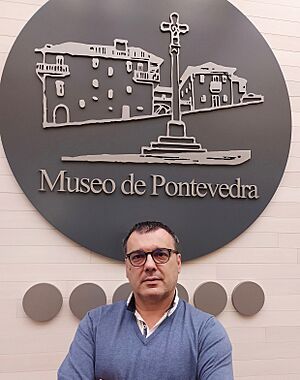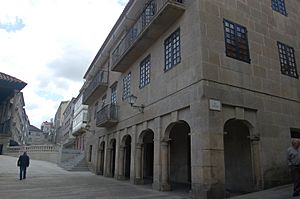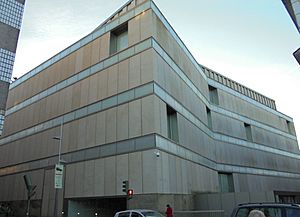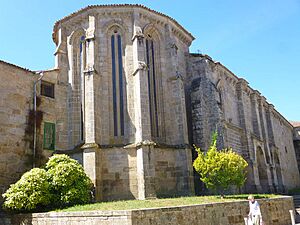Pontevedra Museum facts for kids
| Museo de Pontevedra | |
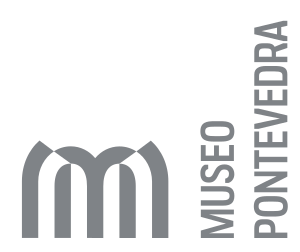 |
|
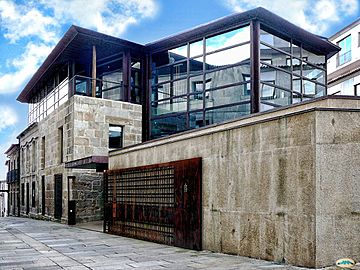
The Fernández López Building extension (2002)
|
|
| Former name | Pontevedra Provincial Museum |
|---|---|
| Established | 30 December 1927 |
| Location | Pontevedra, Spain |
| Type | Art museum, Archaeology museum, Ethnographic museum |
| Visitors | 188,600 (2023) |
| Owner | Provincial Deputation of Pontevedra |
The Pontevedra Museum is a fantastic place to explore history and art in Pontevedra, Spain. It was started on December 30, 1927, by the Provincial Deputation of Pontevedra. This museum is special because it has six different buildings filled with amazing things to see.
You can find both permanent and temporary exhibits here. The museum's collections cover many different areas. These include paintings, sculptures, ancient artifacts (archaeology), beautiful decorative items, engravings, and objects showing how people lived (ethnography).
The Pontevedra Museum was recognized as a very important cultural site on March 1, 1962. It also won the Gold Medal of Galicia in 1996 for its great work.
Contents
Discovering the Museum's History
The Pontevedra Museum first opened its doors to the public on August 10, 1929. It began in a building called the Castro Monteagudo pazo.
Over the years, the museum grew a lot. Since 2012, it has used five old buildings and one new, modern building. The modern building, called the Castelao Building, opened in 2013. The other historic buildings are the García Flórez, Fernández López, Sarmiento, and Castro Monteagudo buildings. There are also the beautiful Gothic ruins of the San Domingo Church.
In 2022, more than 175,000 people visited the museum. It's a very popular place!
Who Manages the Museum?
The museum has had several directors who helped it grow. Here are the people who have led the Pontevedra Museum:
- 1927–1937: Casto Sampedro Folgar
- 1937–1940: Gerardo Álvarez Limeses
- 1940–1986: Xosé Filgueira Valverde
- 1986–2018: José Carlos Valle Pérez
- 2019–2022: José Manuel Rey García
- 2023: Ángeles Tilve Jar
Exploring the Museum Buildings
The Pontevedra Museum is unique because it's spread across several buildings. Each one has its own special history and collections.
Castro Monteagudo Building
This building was built in 1760. It was named after José de Castro y Monteagudo, an important official. This was the very first building of the museum.
It used to show ancient artifacts, old gold jewelry, silverware, and paintings. The museum is currently updating its displays in this building.
Ancient Artifacts Rooms
Three rooms in the Castro Monteagudo building were once dedicated to archaeology. They showed important items from Galicia's very early history. Many of these ancient collections have now moved to the Sarmiento building. However, some traditional Galician gold jewelry still remains here.
Silverware Collection
This building also has a wonderful collection of silverware. It was bought by a writer named Gonzalo Fernández de la Mora y Mon. The collection includes pieces made before 1900. Most of these are everyday items, but some are religious.
The silverware comes from Spain, Latin America, Russia, and China. You can see Russian boxes, Turkish snuff boxes, and Thai cups.
One of the oldest pieces is a Byzantine baptismal cup from the 15th or 16th century. A very interesting item is a box from 1600 that belonged to a preacher named Thomas Hooker. The most valuable piece is a large imperial tureen from the 1800s.
García Flórez Building
The Pazo García Flórez is named after Antonio García Estévez Fariña and his wife Tomasa Suárez Flórez. They built this grand house in the 18th century. It became part of the museum in 1943.
Inside, you can see old furniture and navigation tools. There's even a cabin from a Spanish warship called the Numancia. The collection also features religious sculptures, pottery, and a traditional Galician kitchen. You can also find engravings, Sargadelos earthenware, and jet objects.
Fernández López Building
This building was constructed between 1962 and 1965. It honors José Fernández López, a generous donor. Here, you can see many romantic and historical paintings from the 19th and 20th centuries. There are even special rooms for famous artists like Goya and Joaquín Sorolla.
This building also holds the museum's offices, a large library, and graphic archives. These archives contain over 500,000 records!
The Fernández López building was expanded in the early 2000s. A new part was added in 2002, designed by architect Celestino García Braña. This new section, opened in 2003, provides more space for offices and researchers. It even won an award from the Galician Association of Architects.
Museum Library
The museum's library started with just 108 books. By 2007, it had over 6,000 different magazines and journals. It also had more than 150,000 books and 500 maps. This special library is for researchers. It has a reading room where anyone can look at the collections, but books cannot be taken out.
Ruins of St. Dominic's Convent

This is the oldest part of the museum. It includes the remains of the San Domingo convent. This convent was built in the 14th and 15th centuries. It was abandoned in 1834. Only the main chapel and some side chapels are still standing.
Besides the church ruins, you can see many old coats of arms and tombstones. There are also ancient Visigothic and Romanesque stone carvings and various statues.
Sarmiento Building
This building was once a Jesuit College. It's a beautiful Baroque-style building. Construction started in 1695 and finished in 1714. It stands next to the church of St Bartholomew. The museum took over this building in 1979.
After a big renovation, it reopened in 2013. It now displays archaeological items and medieval Galician art from the 13th century. You can see amazing ancient neck rings (torcs) and other items from the Castro culture. These treasures were found in places like Caldas de Reis and Agolada. Galician pottery is also on display. There are also rooms about the city of Pontevedra and the Pilgrim Virgin.
In a secure room, you can find the treasure of Caldas de Reis. This incredible gold treasure dates back to the Bronze Age. It was found buried in a vineyard in 1940. It is the most important gold treasure in Spain and one of the most important in Europe because of its weight.
Castelao Building
The Castelao Building is the museum's newest addition. It was built between 2004 and 2008. This modern building adds 10,000 square meters for exhibitions and workshops. It opened on January 4, 2013. It is located behind the church of Saint Bartholomew.
This building has four floors and a ground floor. The bottom floor is for temporary exhibitions. The three upper floors have 23 rooms for the museum's permanent collections. These include Galician art from different periods, as well as art from other Spanish and international artists.
The first floor shows Galician art from the Gothic period to the late 19th century. You can see sculptures and relics, like an altarpiece from a convent. There are also paintings and sculptures by artists like Goya and Gregorio Fernández.
The second floor features art from the late 19th century to the early 20th century. Here, you can see works by Ovidio Murguía and Álvarez de Sotomayor. There are also two special rooms dedicated to the famous artist Castelao. The museum has many of Castelao's most important works, including his original album Nós.
The third floor is dedicated to Galician artists from the 20th and 21st centuries. In the basement, you'll find restoration workshops, a large auditorium, and a cafeteria. You can also see parts of the old Pontevedra city walls here.
Santa Clara Convent
On December 1, 2021, the City Council of Pontevedra bought the Saint Clare's Convent. This beautiful convent was purchased from the Poor Clares nuns. On January 3, 2023, the City Council gave the convent complex to the Provincial Deputation. The Deputation plans to restore the convent and make it the museum's seventh building.
Museum Publications
The museum publishes an annual magazine called El Museo de Pontevedra. It first came out in 1942. The museum also publishes special books about its collections and exhibitions.
Exciting Exhibitions
From August to October 2022, the museum hosted a special exhibition. It featured about 75 traditional Galician costumes and crafts. These were inspired by photographs taken by American photographer Ruth Matilda Anderson between 1924 and 1926.
After five years of research, this exhibition showed traditional clothes on mannequins. It also displayed everyday items from the museum's collection. The exhibition recreated scenes from rural life almost 100 years ago. You could see milkmaids, craftsmen selling wooden clogs, and people in traditional straw raincoats. More than 14,000 people visited this popular exhibition.
See also
 In Spanish: Museo de Pontevedra para niños
In Spanish: Museo de Pontevedra para niños
- List of museums in Spain
- Archiepiscopal Towers Interpretation Centre
- Castelao Building
- College of the Society of Jesus in Pontevedra
- Old Town of Pontevedra
- Pazo de Castro Monteagudo
- Pazo de García Flórez
- Ruins of San Domingos


